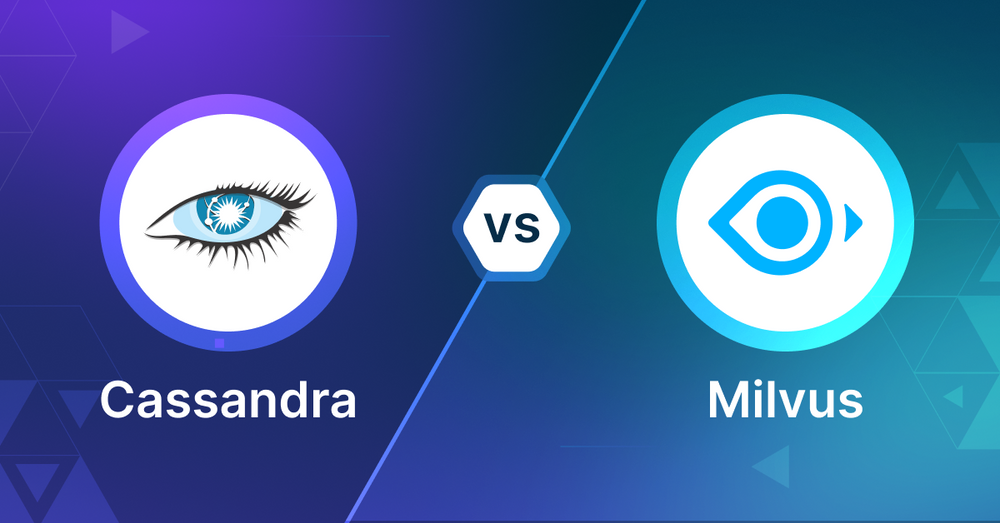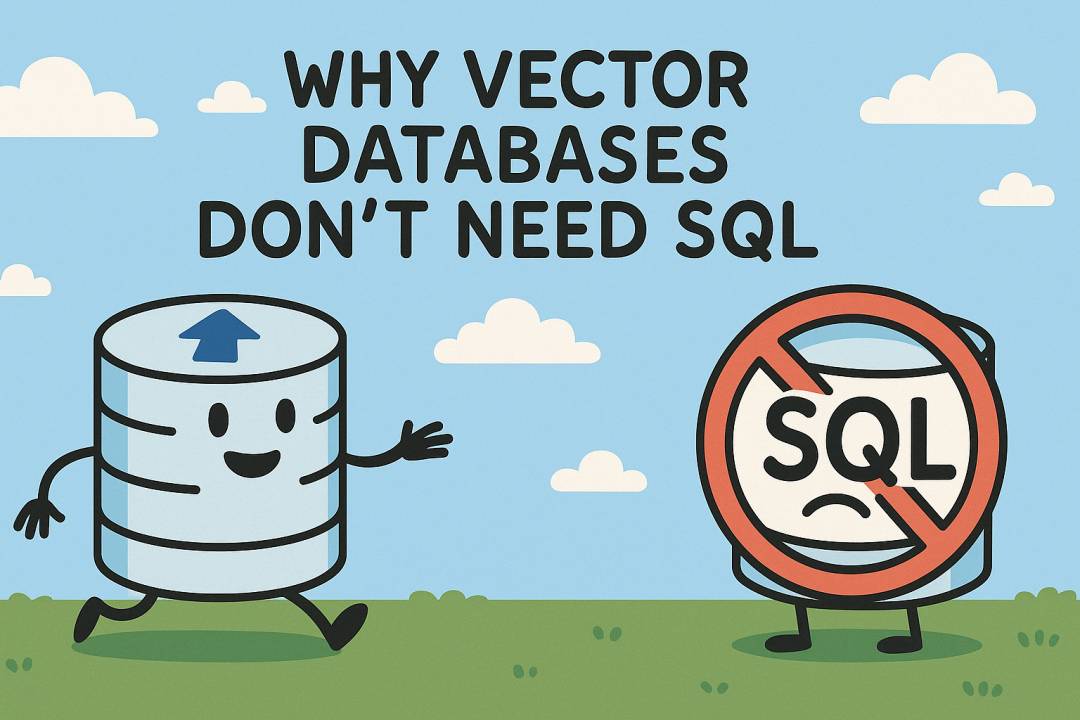Apache Cassandra vs Milvus: Choosing the Right Vector Database for Your Needs

Apache Cassandra vs Milvus: Choosing the Right Vector Database for Your Needs
As AI technologies evolve, the need for vector databases has become more and more critical. These databases are designed to handle vector embeddings—numeric representations of data like text, images, and videos. If you're working on applications like recommendation engines, natural language processing (NLP), or RAG, having a fast and efficient vector database can make all the difference in performance.
Two options in this space are Apache Cassandra and Milvus. While both support vector search, they’re built for different workloads and use cases. If you're trying to decide which one to use for your AI project, this comparison will break down their strengths, limitations, and how they stack up against each other.
What is a Vector Database?
Before we compare Apache Cassandra and Milvus, let's first explore the concept of vector databases.
A vector database is specifically designed to store and query high-dimensional vectors, which are numerical representations of unstructured data. These vectors encode complex information, such as text's semantic meaning, images' visual features, or product attributes. By enabling efficient similarity searches, vector databases play a pivotal role in AI applications, allowing for more advanced data analysis and retrieval.
Vector databases are adopted in many use cases, including e-commerce product recommendations, content discovery platforms, anomaly detection in cybersecurity, medical image analysis, and natural language processing (NLP) tasks. They also play a crucial role in Retrieval Augmented Generation (RAG), a technique that enhances the performance of large language models (LLMs) by providing external knowledge to reduce issues like AI hallucinations.
There are many types of vector databases available in the market, including:
Purpose-built vector databases such as Milvus, Zilliz Cloud (fully managed Milvus)
Lightweight vector databases such as Chroma and Milvus Lite.
Traditional databases with vector search add-ons capable of performing small-scale vector searches.
Apache Cassandra is a traditional NoSQL database that has evolved to include vector search capabilities as an add-on. Milvus is an open-source, purpose-built vector database that can handle billion-scale vector points.
Overview of Apache Cassandra
Apache Cassandra is a distributed NoSQL database known for its high availability, fault tolerance, and scalability across large clusters. Its architecture allows it to handle large volumes of structured and semi-structured data in a distributed environment, making it popular in the telecommunications, retail, and finance industries.
Recently, Cassandra has added vector search capabilities through DataStax, an enterprise distribution of Cassandra. This new feature allows users to manage vector embeddings and perform similarity searches directly within Cassandra without needing a separate database system for vectors. However, Cassandra’s vector search is still relatively new, and its primary strength remains its traditional NoSQL capabilities.
Overview of the Milvus Vector Database
Milvus is an open-source vector database designed from the ground up for vector search and similarity search at its core. It is highly performant and horizontally scalable at a billion scale and can run efficiently across a wide range of environments, from laptops to large-scale distributed systems. Milvus is available as both open-source software and a cloud service (Zilliz Cloud).
Milvus supports at least 11 indexing methods, including HNSW (Hierarchical Navigable Small World), IVF (Inverted File), DiskANN, and CAGRA, allowing it to quickly search through large volumes of data. Unlike Cassandra, Milvus is not a general-purpose database but a focused tool for unstructured data and vector similarity search, making it a more specialized solution.
Milvus is part of the LF AI & Data Foundation and is licensed under Apache 2.0. Many contributors are experts in high-performance computing (HPC), with backgrounds in building and optimizing large-scale systems. Key contributors include professionals from companies like Zilliz, ARM, NVIDIA, AMD, Intel, Meta, IBM, Salesforce, Alibaba, and Microsoft.
Milvus offers three deployment options: Milvus Lite, Standalone, and Distributed.
Milvus Lite is a Python library and an ultra-lightweight version of Milvus. It’s perfect for rapid prototyping in Python or notebook environments and for small-scale local experiments.
Milvus Standalone is the single-node deployment option for Milvus, using a client-server model. You can think of it as the Milvus equivalent of MySQL, while Milvus Lite is like SQLite.
Milvus Distributed is Milvus's distributed mode, ideal for enterprise users building large-scale vector database systems or vector data platforms.
Key Differences between Milvus and Apache Cassandra
Search Methodology
When it comes to search algorithms, the two databases take different approaches.
Apache Cassandra uses relatively simple nearest-neighbor search techniques for vectors, building on top of its traditional indexing and querying features. This means Cassandra’s vector search capabilities are an extension of its general-purpose architecture, making it useful for applications that need both traditional data management and vector search in one system. However, its search speed and efficiency might not match that of specialized tools like Milvus.
On the other hand, Milvus is built from the ground up for vector search, utilizing advanced Approximate Nearest Neighbor (ANN) algorithms (e.g., HNSW, IVF ) for rapid similarity search. These methods are designed to efficiently handle large volumes of high-dimensional data, making Milvus a better choice for use cases where vector search is central, such as large-scale recommendation systems or multimedia search engines. With the launch of its latest releases, Milvus has expanded its search capabilities to include hybrid search, covering hybrid sparse and dense search, hybrid dense and full-text search, multimodal search, and metadata filtering.
Data Handling
While both databases support vector search, they differ in how they handle other types of data.
Cassandra is a general-purpose NoSQL database storing various data types, including structured and semi-structured data. This flexibility makes it ideal for environments where different data types must be managed in one place. For example, if your application combines traditional data like customer records with vector embeddings for product recommendations, Cassandra can handle both in one system.
Milvus, however, is highly specialized and designed primarily for vector data. While it can store some metadata alongside vectors, it’s not intended for complex relational or transactional data. Milvus will be the more efficient choice if your application requires vector search without the need to manage a lot of traditional data.
Scalability and Performance
Both databases are designed to scale but in different ways.
Cassandra excels at linear scalability, allowing you to add nodes to a cluster without impacting performance. This makes it well-suited for applications that handle massive amounts of structured and semi-structured data. However, since vector search is a relatively new feature in Cassandra, its performance in large-scale vector search tasks might not match that of Milvus.
Milvus is optimized for high-performance vector search and scales horizontally to handle datasets of billion-scale vectors. It leverages GPU acceleration to boost performance, especially for applications that rely on real-time vector search. This makes it the clear choice for AI-heavy applications where quick retrieval of similar vectors is a top priority.
Flexibility and Customization
If your application requires flexibility in how you store and query data, Cassandra may be the better choice. Its schema-less architecture allows for custom data models and queries, giving you the freedom to structure your data as needed. Moreover, Cassandra’s robust query language (CQL) offers rich functionality for complex queries, making it ideal for diverse datasets.
In contrast, Milvus is more rigid, focusing exclusively on vector data and search. While it provides customization options for search indexing and algorithms, it lacks the versatility to handle non-vector data types or complex queries outside of vector search. If your application is focused solely on vector search, this specialization can be an advantage, as it simplifies the system and optimizes performance.
Integration and Ecosystem
Cassandra has a rich ecosystem, integrating many popular big data, analytics, and cloud tools. If your project already uses technologies like Apache Spark, Hadoop, or Kafka, Cassandra can integrate seamlessly, making it a good choice for environments requiring comprehensive data pipelines and processing.
Milvus is more specialized, but it also integrates well with many AI and machine learning tools, such as OpenAI's GPT models and embedding models, LlamaIndex, LangChain, Airbyte, PyTorch, and Hugging Face. For developers working heavily with AI frameworks, this makes Milvus an attractive choice, as it simplifies the process of working with vector embeddings and similarity search.
Ease of Use
If your focus is purely on vector search, Milvus has the upper hand in terms of ease of use. Its API is designed for simplicity, making it easy for developers to set up and start querying vectors with minimal overhead. Milvus also has three deployment options catering to different needs. Its fully managed service, Zilliz Cloud, provides a hassle-free vector search experience.
Cassandra, on the other hand, has a steeper learning curve, especially for those new to distributed databases. While its vector search features are straightforward, getting the most out of Cassandra’s distributed architecture requires deeper expertise in database management.
Cost Considerations
Costs can vary significantly depending on the size of your datasets and the infrastructure needed to support them.
Cassandra can get expensive, particularly at scale, when dealing with large clusters of servers. Managing a distributed system like Cassandra requires more resources and can drive up costs, especially for storage and computing power. However, if you’re already using Cassandra for other tasks—such as managing structured or semi-structured data—the cost of adding vector search might be more reasonable than adopting an entirely new database just for vector data.
Milvus, on the other hand, is purpose-built for vector search, so while it can be resource-heavy, especially when utilizing GPU acceleration for faster processing, it generally offers better cost-efficiency for applications that rely heavily on vector search. You’ll get more performance per dollar for workloads focused on querying large sets of vectors. Plus, Milvus provides a managed service through Zilliz Cloud, allowing you to skip the hassle of managing your own infrastructure. This cloud-based option gives you flexibility in scaling as needed without worrying about the overhead of server maintenance.
When to Choose Milvus and Apache Cassandra
Milvus is a better fit if your application is AI-centric and relies on fast, accurate similarity searches over millions or billions of high-dimensional vectors, such as in image recognition, e-commerce recommendations, or NLP tasks. Its performance optimizations, scalability, and focus on high-dimensional data make it ideal for tasks like recommendation engines, multimedia search, or NLP-based applications. Milvus is also easier for developers primarily concerned with vector data to set up and use.
On the other hand, if you need a general-purpose database that can handle both structured data and vector embeddings, Cassandra might be a more fitting choice. It’s particularly well-suited for applications that mix traditional NoSQL capabilities with some vector search functionality, especially in environments where uptime and fault tolerance are critical.
Conclusion
Choosing between Apache Cassandra and Milvus depends largely on your specific use case and the complexity of your data. Milvus excels at vector search and is perfect for AI-heavy applications. At the same time, Cassandra offers more versatility for environments where vector search is an add-on rather than the core focus.
Ultimately, the decision should be based on your application’s performance needs, data types, and scalability requirements.
Using Open-source VectorDBBench to Evaluate and Compare Vector Databases on Your Own
VectorDBBench is an open-source benchmarking tool designed for users who require high-performance data storage and retrieval systems, particularly vector databases. This tool allows users to test and compare the performance of different vector database systems such as Milvus and Zilliz Cloud (the managed Milvus) using their own datasets and determine the most suitable one for their use cases. Using VectorDBBench, users can make informed decisions based on the actual vector database performance rather than relying on marketing claims or anecdotal evidence.
VectorDBBench is written in Python and licensed under the MIT open-source license, meaning anyone can freely use, modify, and distribute it. The tool is actively maintained by a community of developers committed to improving its features and performance.
Download VectorDBBench from its GitHub repository to reproduce our benchmark results or obtain performance results on your own datasets.
Take a quick look at the performance of mainstream vector databases on the VectorDBBench Leaderboard.
Read the following blogs to learn more about vector database evaluation.
Further Resources about VectorDB, GenAI, and ML
- What is a Vector Database?
- Overview of Apache Cassandra
- Overview of the Milvus Vector Database
- Key Differences between Milvus and Apache Cassandra
- Conclusion
- Using Open-source VectorDBBench to Evaluate and Compare Vector Databases on Your Own
- Further Resources about VectorDB, GenAI, and ML
Content
Start Free, Scale Easily
Try the fully-managed vector database built for your GenAI applications.
Try Zilliz Cloud for FreeKeep Reading

Build for the Boom: Why AI Agent Startups Should Build Scalable Infrastructure Early
Explore strategies for developing AI agents that can handle rapid growth. Don't let inadequate systems undermine your success during critical breakthrough moments.

Why AI Databases Don't Need SQL
Whether you like it or not, here's the truth: SQL is destined for decline in the era of AI.

Knowledge Injection in LLMs: Fine-Tuning and RAG
Explore knowledge injection techniques like fine-tuning and RAG. Compare their effectiveness in improving accuracy, knowledge retention, and task performance.
The Definitive Guide to Choosing a Vector Database
Overwhelmed by all the options? Learn key features to look for & how to evaluate with your own data. Choose with confidence.